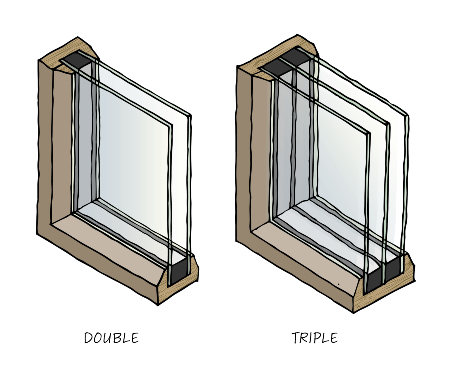Illustration of double and triple glazing
Single-glazed windows can let as much as 60% of the heat escape from your home. This is detrimental in terms of the cost of your heating, and the cost to the planet.
Double or triple glazing is formed by two or three window panes separated by a gap filled with air or another gas such as Argon, to create an insulating barrier limiting heat transfer through windows. The panes are separated with spacers that should be designed to prevent heat loss and condensation. Triple-glazing is optimal in terms of efficiency because it further insulates the building. The more layers of glass the window has, the less heat loss there is.
To maximize the insulating effect of double and triple glazing, the optimum gap required between the panes of glass is about 12-16mm. Too close together results in radiant heat loss; too far apart leads to creation of gas currents which causes convection current heat losses.
A window’s thermal transmittance, or how effectively it stops heat escaping, can be expressed as a U-value. Simply put, the higher the U-value, the more heat a window loses. Typically, the U-values (measured in w/m2K) of different window glazing options can be around:
- single glazing = 5 to 5.6
- double glazing (with air cavity) = 2.8
- double glazing (with argon gas cavity) = 2.6
- double glazing with low emissivity glass (with air cavity) = 1.8
- double glazing with low emissivity glass (with argon gas cavity) = 1.5
- triple glazing = 0.7 to 1.6
As such, when compared to single-glazed windows, both double and triple glazing are highly effective retrofitting measures in terms of energy efficiency and potential energy saving cost.
It pays to shop around for quotes. Prices will vary significantly based on a number of factors, including:
- the materials used. Most notably, whether the windows are uPVC (which are the least expensive option) or wooden (which are more expensive)
- how many windows you want to get replaced
There may be some financial support available to help with replacing windows. We recommend looking online to find grants or schemes which you may be eligible for.
Listed Building Consent is required for installation of new double-glazed windows.
As an alternative to double glazing, in cases involving heritage assets, we suggest, where appropriate, the use of slim profile double glazing or secondary glazing. If measured and fitted properly, and combined with timber shutters and heavy curtains, the energy saved in cold weather can be nearly as good as standard double glazing units.
We are unlikely to support the use of standard width double-glazed units or triple-glazed units in listed buildings other than on existing or proposed modern extensions. This is because they are not regarded as consistent with the traditional character and appearance of listed buildings, and would likely conflict with the requirement to preserve the special architectural or historic interest of the building.
Traditional Windows: their care, repair and upgrading from Historic England
Historic Engalnd's Library of guidance for altering windows
Modifying historic windows as part of retrofitting energy saving measures is also available from Historic England

